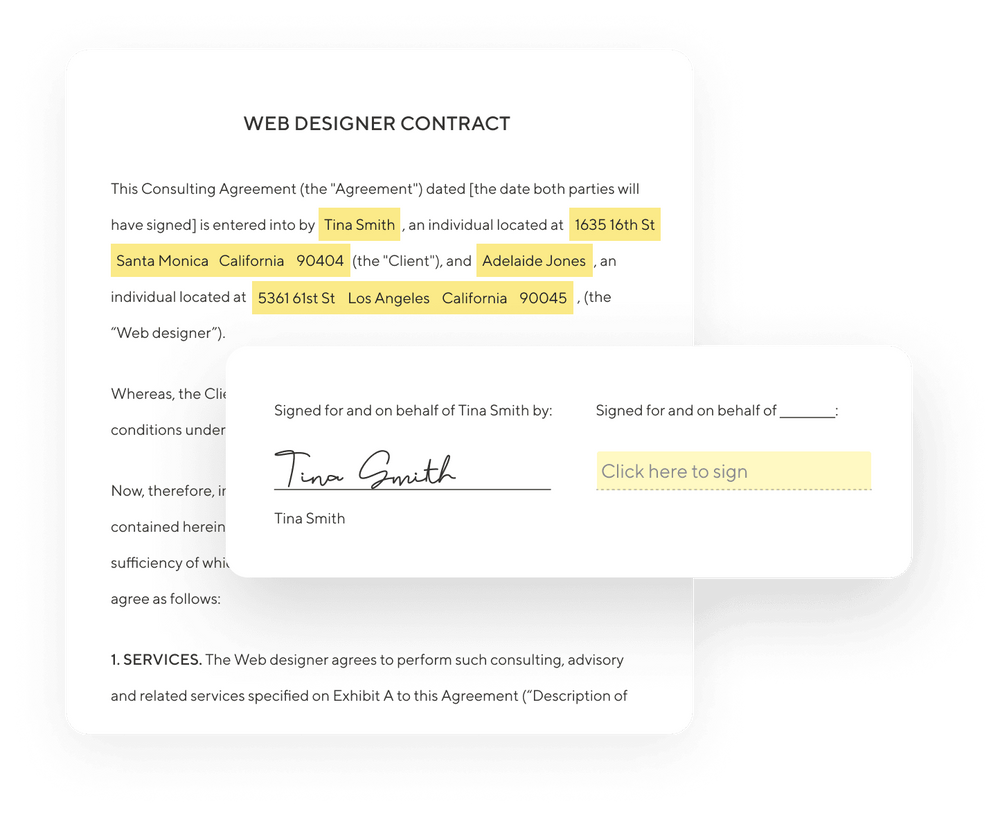Even the most straightforward commercial construction project comprises many tasks involving workers, equipment, work details, and supplies. Tasks need to be completed to agreed timelines, regulatory guidelines, and industry standards. Delays in an upcoming construction project are common as setbacks can be discovered in preparatory work, which wasn't clear at the outset.
With all this complexity, it is vital to detail all aspects of the project in simple language fully. Then both the project manager and the client clearly understand the expected deliverables, the goals, the outcomes, and the timeline over which certain milestones will be achieved. Indy can help you get this done with our Contracts and Projects tools. We’ve also written this guide to help you get started. Let’s get into it.
Difference Between Statement of Work and Scope of Work
A Statement of Work document summarizes construction projects in total. It is a formal construction contract written in plain language, usually stating the aims of a project and its context within legal requirements.
The Statement of Work clearly defines the project's requirements, the tasks it asks for, workflows, and a breakdown of costs. It can also highlight unforeseen project challenges, estimates of the time delays involved, and the necessary remedial work required to rectify them.
By establishing a contractual agreement, such as a Statement of Work, between the project manager and the client, both parties clearly understand their position in a brief statement. It's much more likely the client's expectations will be met, and the contractual nature ensures potential disputes are fairly solved.
The Scope of Work (SOW) is a planning document defining specific tasks, which helps to establish objectives and has more detail than the Statement of Work, which presents a good scope of the expectations for all parties involved in the project. Essential information usually includes obligations, tasks, and responsibilities for the contractor and any other stakeholders involved in the project.
The SOW will vary depending on the application but usually involves anything that might influence the outcome during the project management. As a quick overview, it also defines goals, milestones, evaluation criteria, limitations, contract terms, and the payment schedule in the final product.
Benefits of Writing a Scope of Work for a Contractor
Expectations are clear for everyone
With a clearly defined SOW documented for all parties involved, everyone is working on the same page. Construction projects are a team effort that requires cooperation for success, and the SOW acts to provide guidance and clarity so misunderstandings are minimized.
Better quality control
The project outcome is more assured by detailing each aspect of a project, such as timelines, deliverables, and responsibilities in the SOW. Tracking and monitoring during the project can also be built in for further control.
Improved cost control
With a detailed framework of costs, including materials, labor, and additional necessary resources, it's possible to keep expenditures within the client's budget and maintain effective cash flow management.
Identify and manage project risks to reduce them
Some risks during a project may be evident from the outset. Difficult site access or geographical features may present a risk. These can be discussed, and the workflow and cost established to overcome them so the scope of work for the contractor runs smoothly during the project.
Construction Contractor Scope of Work Writing Process
Step 1: Introduce the Project
All steps within the SOW should be written in simple, clear English that everyone can understand. As with many business sectors, construction involves a lot of jargon and abbreviations, which can be difficult for the layperson to understand. Simplicity and everyday language are key.
Write a simple but descriptive name for the construction project and include the client and contractor's full contact details.
Identify the project problem statement. The construction project is needed to either solve a problem or create a benefit for the client. So, the problem statement should describe the issue and also detail the required work to address it. Usually, the statement is a brief description that clearly lets the client understand the problem and the goal.
Often in construction, the project goals of cost, time, and quality are regarded as the main quantifiers of a project's success. However, the lesser-regarded elements, such as safety, environmental impact, and customer satisfaction can often be the more significant drivers.
Project goals should include a detailed breakdown of the individual milestones and goals that must be achieved as the project progresses. It's vital that contractors have a clear outline of what needs to be done, such as design specifications, and that the work meets the required standards.
Step 2: Summarize the Objectives
Defining both the primary objectives of the project and the tasks the team must complete helps to crystallize the project scope in all parties' minds. This can be detailed as bullet points for clarity, although more extensive objectives may need to be summarized in conventional paragraphs. A well-written scope should always be written with the minimum number of words to convey the whole meaning required.
This way there is no chance of misunderstandings between parties during the execution of the work. It's worth including brief troubleshooting guidance as well. Any tasks or activities that have the potential to delay the project objectives should be mentioned. Forewarned, project managers will be better able to react should these problems arise.
What does the project aim to achieve?
In construction, any new project requires relevant information from many parties to define what problems must be solved and what needs must be met. Once these are established, it is possible to determine how the project can best proceed, with clear goals and practical objectives. These objectives are constrained by several factors including budgeting, available resources, planning and environmental considerations, and potential risks that may affect the outcome.
Liaising regularly with the client to discuss the key elements at this stage helps to cement the project requirements. Both parties sign off the proposal as it progresses, so there is no danger of scope creep, where the client may add additional tasks without asking for official approval. In this process, the overall aim is to align the project objectives with the client's needs and expectations, so that both parties are satisfied with the end result.
Incorporating SMART goals
When setting goals for a construction project it can be highly effective to incorporate the methodology of SMART goals. The acronym stands for five characteristics, Specific, Measurable, Attainable, Relevant, and Time-Bound. Normally goals are simply aspirations you aim to achieve. However, by quantifying the elements of these goals using the SMART technique it is possible to include much finer, objective detail, such as resources, deadlines, and possible hold-ups on the way.
Step 3: Describe the Actual Scope of Work
The scope of work section should include all the project goals that need to be achieved. Adequate relevant information needs to be included so that contractors will be able to fully understand the project requirements. So, this should include full information on the smaller tasks that make up these goals for clarity.
While the project goals and tasks should, at this stage, be clearly defined, the construction schedule may still need to be finalized. However, there should be a good working timeline for the project, which can be based on the timings for each of the tasks. The timeline for each of these tasks can be represented visually on a chart to give an overall timeline impression for the project.
Step 4: Detail the Project Tasks
The overall tasks and activities that the contractor carries out on-site gradually contribute towards achieving the project objectives. For each of these tasks, key information needs to be specified, such as the required tools, the resources and materials, and the necessary skill set. In addition, there needs to be an explanation of how each of the tasks will be carried out, as well as progress monitoring during the execution.
The complexity of many construction projects often means they are composed of numerous smaller tasks and subtasks, which are carried out by different contractors at different times throughout the project. Keeping tabs on each of these tasks can be difficult but it is made easier by using a Gantt chart, a visual representation that enables the viewer to more easily see when a particular task starts and how long it goes on. Additional information can be included such as who is responsible for the task, cost, and deadline.
Step 5: State the Project Schedule
Using estimates from subcontractors on their individual timings for tasks and the information from the Gantt chart it should be possible to create a realistic overall project timeline. It helps to break the project down into manageable key milestones and goals, which enables the focus to be more in the present rather than continually relying on a distant endpoint.
By nature, construction projects can fall prey to a number of risks that may delay the finish. These can include poorly conceived scope projects, availability and cost of materials, labor shortage, site accidents and breakdowns, and the weather. With experience, some of these factors can be mitigated so it is always important to include them in any scope.
There are many project management software choices, which are aimed at the construction industry. Often cloud-based they can be accessed by anyone, anywhere, which is an important consideration with the unpredictable working conditions. The range of tools are aimed to organize the tracking and control of planning, costs, project milestones, timelines, and many more.
Step 6: List the Project Deliverables
In a construction project project deliverables are defined as the products, services and results that that project creates. It might be easy to assume that project deliverables are the final result of the end of the project but they can also include products and results that are created throughout the duration of the project. Deliverables can be tangible or intangible and internal or external and associated with products or services. The internal project deliverables are not connected with clients or customers, while the external ones are.
Sample project deliverables in construction can include design drawings, design documents, completed products (such as houses, extensions premises, etc), or a site investigation report.
Quality control
In construction, there are two parameters for quality, firstly, quality assurance (QA) and secondly, quality control (QC). The first of these lays down the quality management expectations and how these expectations are going to be achieved. The role of quality control is the plan to achieve quality management expectations.
There are several approaches to quality control management in construction. Each one has its own pros and cons depending on the needs and scope of the projects. The International Organization for Standardization established a set of quality standards called ISO 9001.
The seven standards included in ISO are based on the inclusion of stakeholders, customer focus, leadership, process approach, improvement, evidence-based decision making, and relationship management. These standards aim to quantify the different quality parameters within a construction project, so the quality assurance goals are met.
Step 7: Specify an Adoption Plan
Towards the end of any project management plan the client finally takes on board the outcome of the project. The end users who are most affected by the outcomes of the project adopt the changes into their day-to-day routines.
In any construction program, the deliverables are presented to the clients and stakeholders. Some of these deliverables will be presented during the ongoing project and some at the conclusion. Communication with clients and stakeholders is via the project manager's reports. Clients and stakeholders will have differing requirements and so it's necessary to edit the project manager's reports to their particular audience.
In the process of adoption, it may be necessary to educate or re-educate stakeholders and clients, who may have forgotten or missed the stages leading up to adoption. As observers, they may not have had the opportunity to fully understand what the new goals have achieved.
Step 8: State Project Management Roles
When care and attention goes into the planning and recruitment of talent for a project team, the end product is much more likely to succeed. That team will be much more likely to have the skills and experience to successfully create and carry out project tasks that are measurable, realistic, specific, and attainable.
Project manager
The leading role in project management is the project manager, who is simply tasked with completing a successful project. This varied role fulfills many functions including moving the project forward within the timeframe, achieving the objectives with adequate resources, and keeping the project within budget. The project manager also has to regularly brief the client and stakeholders about progress.
Project team members
In a construction project, the role of project team members is taken by subcontractors that work in different fields. They are often a mix of employees and external consultants. Their roles are to further the project objectives and complete deliverables using their particular expertise.
Project and executive sponsors
Project sponsors usually work for the client company and oversee the complete project. They work with the project manager on the high-level planning the project requires.
Business analysts
A business analyst is usually employed to recommend the best business solutions for the client company or organization. They work within the project team but their remit has more critical objectives, for example, solving any existing issues within the organization, making it more efficient, as well as the overall project's objectives.
Communication
It is usual for the workers of a construction project to use all the conventional forms of communication on the job site. They will also attend regular meetings and often use radios and hand signals. Most of these methods can fail from time to time with the loss of significant details and so the steady adoption of cloud-based collaboration and internal communication apps has seen particular growth.
Managing Change and Conflicts
Unexpected changes and conflicts with stakeholders need to be quickly addressed and dealt with before they affect the project's progress. It's not unusual for clients to ask for extra deliverables that weren't in the original scope.
The additional project details need to be costed and, if possible, a way found for the new work documents to be incorporated into the workflow. Ideally, working with the construction manager, the creation of a 'workflow for managing change orders' work template can accommodate the new client requirements. This should offer clear expectations, address the legal requirements, and convey this information to all parties involved.
How Indy Helps Construction Contractors
Hey there, if you're looking to make your life a bit easier when it comes to nailing down a scope of work for construction contractors, you gotta check out Indy. Let me tell you how this nifty tool can help you out:
- First up, Indy's got this sweet Calendar tool that makes scheduling meetings, keeping track of time, and watching those deadlines a piece of cake. Oh, and it plays nice with Google Calendar too, so you're always in the know.
- Need to keep all those tasks in check? Indy's Task tool has got you covered. Filter, search, and pin tasks on cool visual boards and lists that even link up with your calendar. That’s what we call being organized!
- Whip up professional project proposals in no time flat with Indy's easy-to-use templates. You'll be impressing clients left and right.
So, why not give Indy a shot? You can manage your whole project on one platform, and trust me, it's worth a try.
Conclusion
Alright, so we all know that construction projects can be a real handful, right? They need some serious planning and spot-on execution to pull off. That's where the statement of work (SOW) and scope of work (SOW) come into play. These handy documents lay out every little detail of your project, from cost and quality requirements to avoiding any bumps in the road.
Now, here’s Indy, your new best friend for managing construction projects and scope of work docs like a pro. With a bunch of awesome features like an easy-to-use calendar app, a super-efficient to-do list, and top-notch templates, Indy makes the whole process a breeze. You'll be creating killer SOWs in no time, making sure your project goals and objectives are crystal clear and totally doable. Your clients will be thrilled, and your projects will be smooth sailing from start to finish.




